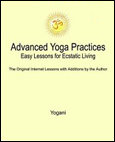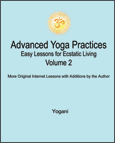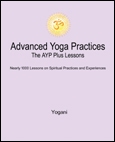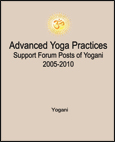|
Public Home | Plus Home | Main Lessons | Tantra Lessons | Public Forum | Plus Forum | Downloads | Books Topic Paths | Search | Training-Retreats | Testimonials | Survey | Interviews | MultiMedia | Contact | Donate |
|
Advanced Yoga Practices Note: For the Original Internet Lessons with additions, see the AYP Easy Lessons Books. For the Expanded and Interactive Internet Lessons, AYP Online Books, Audiobooks and more, see AYP Plus. Lesson T65 - Neo-Tantra (Audio)
From: Yogani New Visitors: It is recommended you read from the beginning of this tantra yoga archive, as previous lessons are prerequisite to this one. The first lesson is, "What is tantra yoga?"
A: Tantra is one of the oldest integrated systems of spiritual practice in the world. Perhaps the oldest. The earliest tantric writings from ancient India go back 4000 years or more, far older than the writings of yoga, and contain many of the same components we find in yoga and other systems of spiritual practice around the world. We can only assume that the relatively more recent systems either borrowed from tantra, or made the same discoveries about the mechanisms of human spiritual transformation that tantra had already incorporated millennia before. Besides being old, tantra is also very wide-ranging in incorporating all aspects of human behavior into the mix of spiritual practices, including behaviors that have been considered extreme at times according to the cultural standards of human civilization over the centuries. For this reason, tantra has been used selectively according to the cultural standards of the time, or not used at all in times when ethical conformity was highly enforced. In fact, tantra became quite obscure and, oddly enough, only began to find a public resurgence in India and started to spread around the world when English translations of some of its ancient scriptures began to appear in the 19th century. Of course, the "human behavior" we are speaking of has to do with the role of sexual energy in spiritual development, and other kinds of conduct that may have been considered to be socially or religiously unacceptable. But especially sex, because this plays a vital role in the awakening of ecstatic conductivity (kundalini) in the human nervous system, and addressing this directly has often crossed the lines of propriety in societies where sex has been neatly bundled up in the customs and taboos of the time. Meanwhile, all of the religions have recognized a relationship between sex and spiritual development, at least minimally. This is why we often find celibacy in the priesthood, and recommendations for sexual restraint in the general population. We now know that restraint of reproductive sexual expression is one-half of the formula. The full role of sexuality in spiritual development also requires the cultivation of sexual energy overtly, covertly, or both. Preservation and cultivation of sexual energy is the formula we have been applying in the AYP lessons, in conjunction with other spiritual practices. Which brings us around to "neo-tantra." While "old tantra" encompasses a wide range of practices that overlap with the full scope of yoga, "neo-tantra" refers to the modern western application of tantric methods relating primarily to sexual practices. It is human nature to separate parts from the whole to accommodate the need of the moment. With the sexual revolution and a general increase in spiritual awareness occurring in the west in the late 20th century, there has been a rising need to understand sex better in relation to spirituality. The rise of neo-tantra has been a response to that need, often disregarding the broader scope of methods that have been part of tantra for thousands of years meditation, breathing techniques, physical postures, etc. Likewise, we have seen a separation of other elements of tantra/yoga in the modern obsession for yoga postures (neo-yoga), and the rising enthusiasm for non-dual self-inquiry (neo-advaita). Each of these is a fragmentation of the whole of knowledge taken to fulfill a perceived need of the time. There is nothing wrong with this, as long as the whole is eventually incorporated. We all have to start somewhere, and hopefully move forward from there to a broader understanding and effective integration of practices leading to good long term results. While we have presented tantra as a separate category of lessons in AYP, we are much in favor of integrating the whole of tantra/yoga. In making tantra a separate category, dealing mainly with sexual techniques, we have hopefully addressed concerns that anyone might have regarding sexual methods in relation to the field of yoga. The benefits of yoga can be gained in the main lessons without any obligation to delve into tantric sexual methods. Likewise, those who are attracted to tantric sexual methods can find many connection points back into the whole of yoga in the main lessons. All of the AYP lessons constitute an integrated whole. Are the AYP tantra lessons neo-tantra or old tantra? It can be viewed either way. If it is only sexual techniques the aspirant has come looking for, then this is neo-tantra. If one comes looking for sexual techniques and finds the broad scope of tantra/yoga in the process, then this is not neo-tantra anymore. It is the full scope, the whole enchilada. What it is will be defined by the user. The same goes for neo-anything else, meaning focusing on any fragment of spiritual knowledge and practice as separate from the whole. All parts lead to the whole. The goal in AYP is to provide doorways to the whole from any of the parts. This is consistent with the spiritual capabilities of the human nervous system, which are fully interconnected on the inside. Anyone who engages in one or two practices will find that this can lead to a range of practices. We can begin our journey anywhere heart, mind, body, breath, sexuality and ultimately we will find the whole of what we are, assuming we are willing to walk through the door that opens in front of us. That is for each of us to decide. If we remain open, we are bound to encounter the old as we are addressing the new. It is balancing the need of the moment with the vast wisdom that whispers within us. In doing so, we find our awakening to the eternal freedom that is always in the present. The guru is in you. Discuss this Lesson in the AYP Plus Support Forum Note: For detailed instructions on the methods of tantra in relation to the broad scope of yoga practices and the enlightenment process, see the AYP Tantra book, and AYP Plus. |
|
|
|
Join the Mail List:
AYP Retreats
eBooks - PDF, EPUB
FREE eBooks with
SAVE with Bundled
|

























